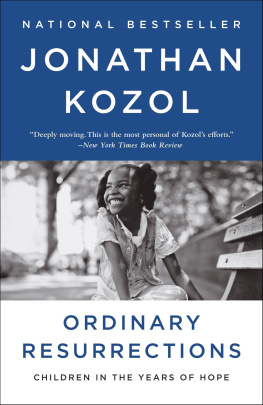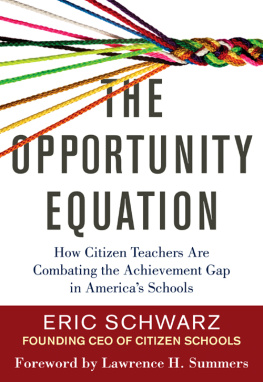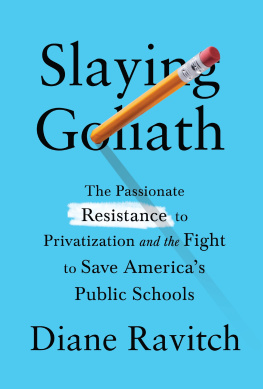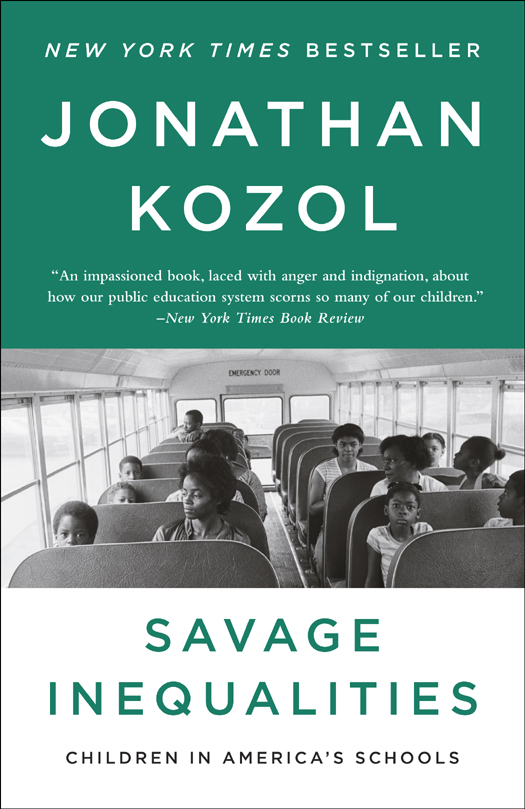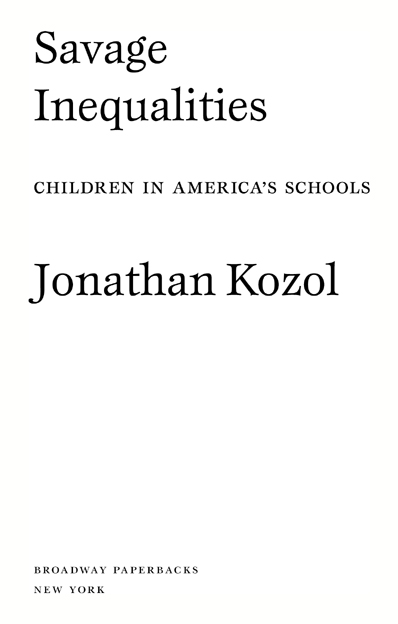PRAISE FOR
Savage Inequalities
Easily the most passionate, and certain to be the most passionately debated, book about American education in several years A classic American muckraker with an eloquent prose style, Kozol offers an old-fashioned brand of moral outrage that will affect every reader whose heart has not yet turned to stone.
Entertainment Weekly
Moving Shocking Heartbreaking.
Ruth Sidel, The Nation
It is neither ironic nor paradoxical to call Savage Inequalities a wonderful bookfor Kozol makes it clear that there are wonderful teachers and wonderful students in every American school, no matter what ugliness, violence, and horror surround the building.
Chicago Tribune
The great virtue of Jonathan Kozols new book about inner-city schools is that it overcomes that everybody knows problem by bringing an undulled capacity for shock and outrage to a tour of bad schools across the country. As soon as Kozol begins leading the way through a procession of overcrowded, underheated, textbookless, barely taught classrooms, the thought he surely intended to engender begins to take form: How can this be?
Washington Post Book World
Poor children of all colors are increasingly looked upon as surplus baggage, mistakes that should never have happened. Indeed, an older view is returning that any attempts to educate the lower orders are doomed to fail. There can be more than one way to read the title of Jonathan Kozols depressingand essentialbook.
Andrew Hacker, New York Times Book Review
Mr. Kozol exposes lemons in American educational facilities in the same way Ralph Nader attacked Detroit automobile makers.
Herbert Mitgang, New York Times
This book digs so deeply into the tragedy of the American system of public education that it wrenches the readers psyche. A must-read for every parent, every educator, and every relevant policymaker.
Alex Haley, author of Roots and
The Autobiography of Malcolm X
A powerful appeal to save children by redistributing the wealth. It will cause angry, but perhaps fruitful, debate.
Kirkus Reviews
Startling and compelling Crucial to any serious debate on the current state of American education.
Publishers Weekly
A superb, heart-wrenching portrait of the resolute injustice which decimates so many of Americas urban schools.
David J. Garrow, Pulitzer Prizewinning
author of Bearing the Cross
Also by Jonathan Kozol
FIRE IN THE ASHES
LETTERS TO A YOUNG TEACHER
THE SHAME OF THE NATION
ORDINARY RESURRECTIONS
AMAZING GRACE
RACHEL AND HER CHILDREN
ILLITERATE AMERICA
ON BEING A TEACHER
CHILDREN OF THE REVOLUTION
THE NIGHT IS DARK AND I AM FAR FROM HOME
FREE SCHOOLS
DEATH AT AN EARLY AGE

Copyright 1991 by Jonathan Kozol
All rights reserved.
Published in the United States by Broadway Paperbacks,
an imprint of the Crown Publishing Group,
a division of Random House, Inc., New York.
www.crownpublishing.com
Broadway Paperbacks and its logo, a letter B bisected on the diagonal, are trademarks of Random House, Inc.
Originally published in hardcover in the United States by Crown Publishers, Inc., a division of Random House, Inc., New York, in 1991.
Library of Congress Cataloging-in-Publication Data is available upon request.
eISBN: 978-0-7704-3666-7
Cover design by Darren Haggar
Cover photograph: Bettmann/CORBIS
v3.1
For Cassie
And for D.K. with love
CONTENTS
TO THE READER
A Clarification About Dates
and Data in This Book
The events in this book take place for the most part between 1988 and 1990, although a few events somewhat precede this period. Most events, however, are narrated in the present tense. This is important to keep in mind because statistics, such as money spent in a particular school district, or a description of the staff or student body in a given school, apply to the year of which Im speaking, which is indicated in the text or notes.
The names of students in this book have sometimes been disguised at their request or that of school officials. The names of all adults are real, although in a few cases adults are not named at all at their request. Documentation for statistics and matters of record in this book is provided in the notes beginning on .
Looking Backward:
19641991
It was a long time since Id been with children in the public schools.
I had begun to teach in 1964 in Boston in a segregated school so crowded and so poor that it could not provide my fourth grade children with a classroom. We shared an auditorium with another fourth grade and the choir and a group that was rehearsing, starting in October, for a Christmas play that, somehow, never was produced. In the spring I was shifted to another fourth grade that had had a string of substitutes all year. The 35 children in the class hadnt had a permanent teacher since they entered kindergarten. That year, I was their thirteenth teacher.
The results were seen in the first tests I gave. In April, most were reading at the second grade level. Their math ability was at the first grade level.
In an effort to resuscitate their interest, I began to read them poetry I liked. They were drawn especially to poems of Robert Frost and Langston Hughes. One of the most embittered children in the class began to cry when she first heard the words of Langston Hughes.
What happens to a dream deferred?
Does it dry up
like a raisin in the sun?
She went home and memorized the lines.
The next day, I was fired. There was, it turned out, a list of fourth grade poems that teachers were obliged to follow but which, like most first-year teachers, I had never seen. According to school officials, Robert Frost and Langston Hughes were too advanced for children of this age. Hughes, moreover, was regarded as inflammatory.
I was soon recruited to teach in a suburban system west of Boston. The shock of going from one of the poorest schools to one of the wealthiest cannot be overstated. I now had 21 children in a cheerful building with a principal who welcomed innovation.
After teaching for several years, I became involved with other intereststhe health and education of farm-workers in New Mexico and Arizona, the problems of adult illiterates in several states, the lives of homeless families in New York. It wasnt until 1988, when I returned to Massachusetts after a long stay in New York City, that I realized how far Id been drawn away from my original concerns. I found that I missed being with schoolchildren, and I felt a longing to spend time in public schools again. So, in the fall of 1988, I set off on another journey.
During the next two years I visited schools and spoke with children in approximately 30 neighborhoods from Illinois to Washington, D.C., and from New York to San Antonio. Wherever possible, I also met with children in their homes. There was no special logic in the choice of cities that I visited. I went where I was welcomed or knew teachers or school principals or ministers of churches.
What startled me mostalthough it puzzles me that I was not prepared for thiswas the remarkable degree of racial segregation that persisted almost everywhere. Like most Americans, I knew that segregation was still common in the public schools, but I did not know how much it had intensified. The Supreme Court decision in


